Parking TOYOTA GR86 2022 Owners Manual (in English)
[x] Cancel search | Manufacturer: TOYOTA, Model Year: 2022, Model line: GR86, Model: TOYOTA GR86 2022Pages: 582, PDF Size: 86.38 MB
Page 4 of 582
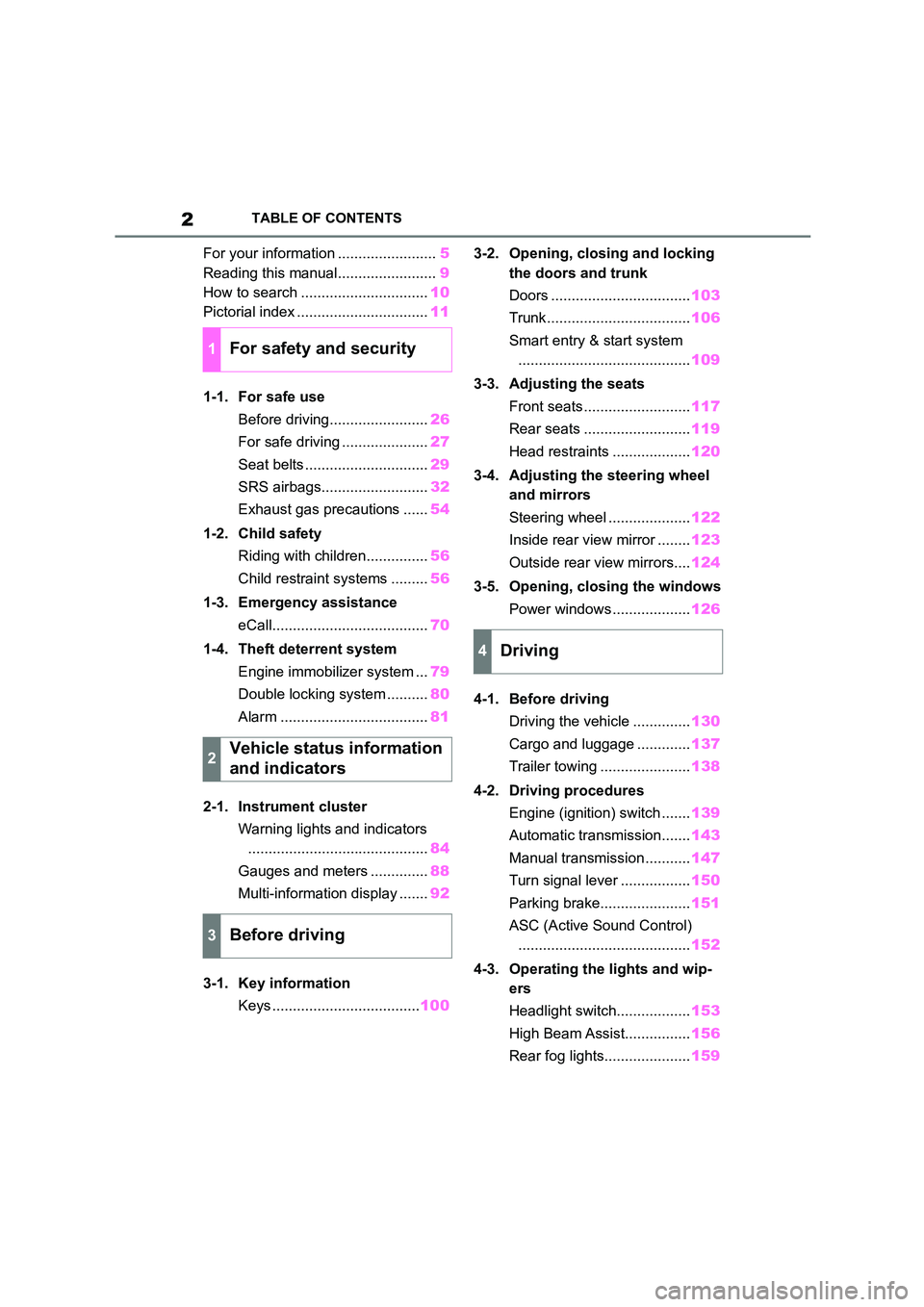
2TABLE OF CONTENTS
For your information ........................5
Reading this manual........................ 9
How to search ............................... 10
Pictorial index ................................ 11
1-1. For safe use
Before driving........................ 26
For safe driving ..................... 27
Seat belts .............................. 29
SRS airbags.......................... 32
Exhaust gas precautions ...... 54
1-2. Child safety
Riding with children............... 56
Child restraint systems ......... 56
1-3. Emergency assistance
eCall...................................... 70
1-4. Theft deterrent system
Engine immobilizer system ... 79
Double locking system .......... 80
Alarm .................................... 81
2-1. Instrument cluster
Warning lights and indicators
............................................ 84
Gauges and meters .............. 88
Multi-information display ....... 92
3-1. Key information
Keys .................................... 100
3-2. Opening, closing and locking
the doors and trunk
Doors .................................. 103
Trunk................................... 106
Smart entry & start system
.......................................... 109
3-3. Adjusting the seats
Front seats .......................... 117
Rear seats .......................... 119
Head restraints ................... 120
3-4. Adjusting the steering wheel
and mirrors
Steering wheel .................... 122
Inside rear view mirror ........ 123
Outside rear view mirrors.... 124
3-5. Opening, closing the windows
Power windows ................... 126
4-1. Before driving
Driving the vehicle .............. 130
Cargo and luggage ............. 137
Trailer towing ...................... 138
4-2. Driving procedures
Engine (ignition) switch ....... 139
Automatic transmission....... 143
Manual transmission ........... 147
Turn signal lever ................. 150
Parking brake...................... 151
ASC (Active Sound Control)
.......................................... 152
4-3. Operating the lights and wip-
ers
Headlight switch.................. 153
High Beam Assist................ 156
Rear fog lights..................... 159
1For safety and security
2Vehicle status information
and indicators
3Before driving
4Driving
Page 16 of 582

14Pictorial index
Parking brake .................................................................................P.151
Applying/releasing............................................................................P.151
Precautions for winter season..........................................................P.261
Warning lights ..................................................................................P.336
Headlight switch ...........................................................................P.153
Turn signal lever ............................................................................P.150
Headlights/front position lights/tail lights/daytime running lights ......P.153
Rear fog light....................................................................................P.159
Windshield wiper and washer switch ..........................................P.160
Usage...............................................................................................P.160
Adding washer fluid..........................................................................P.300
Headlight cleaners ...........................................................................P.160
Emergency flasher switch.............................................................P.326
Hood lock release lever .................................................................P.293
Tilt and telescopic steering lock release lever ............................P.122
Adjustment .......................................................................................P.122
Air conditioning system ................................................................P.264
Usage...............................................................................................P.264
Rear window defogger .....................................................................P.266
Audio system*2
*1: Vehicles with an automatic transmission
*2: Refer to “Multimedia owner’s manual”.
Page 22 of 582
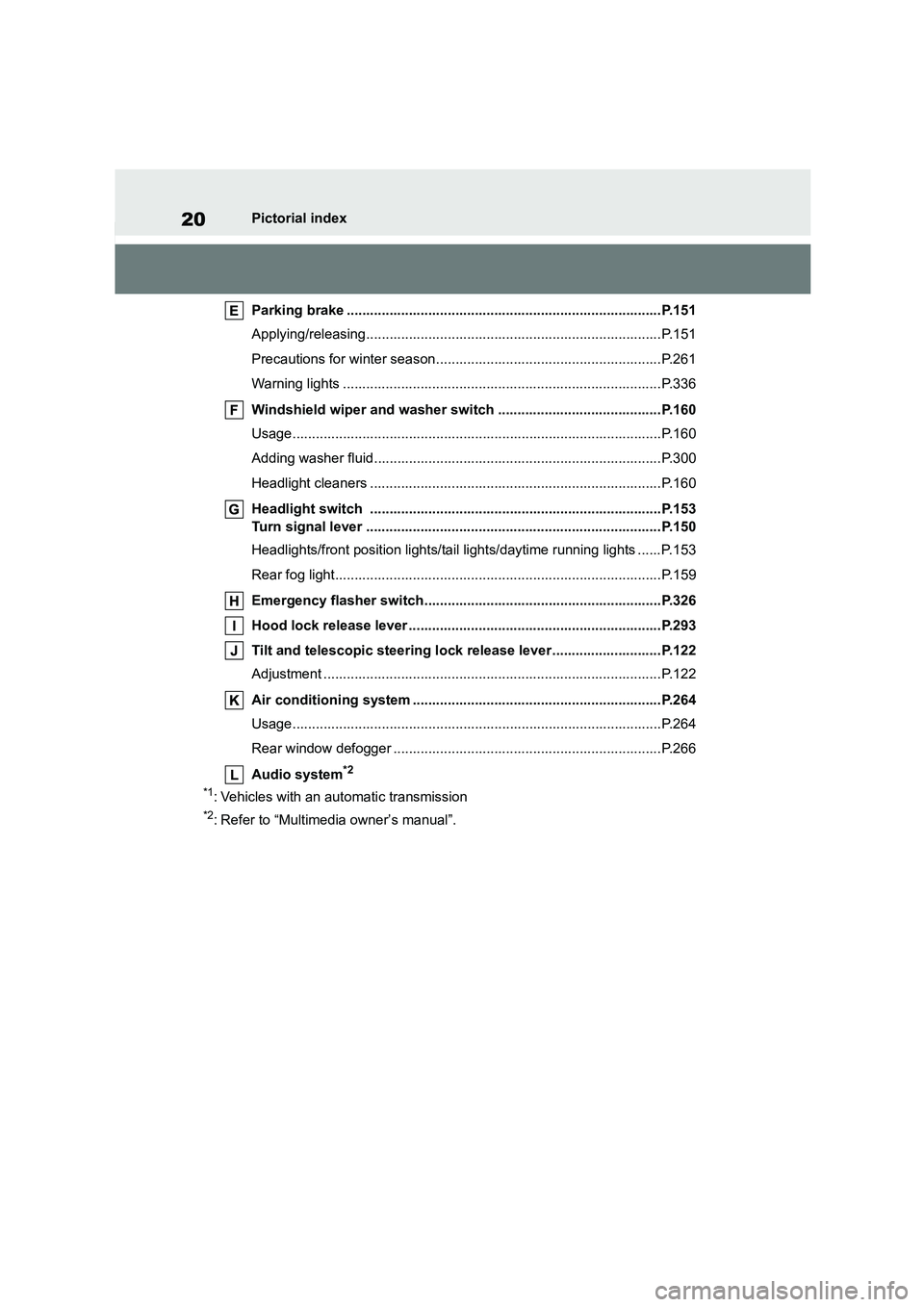
20Pictorial index
Parking brake .................................................................................P.151
Applying/releasing............................................................................P.151
Precautions for winter season..........................................................P.261
Warning lights ..................................................................................P.336
Windshield wiper and washer switch ..........................................P.160
Usage...............................................................................................P.160
Adding washer fluid..........................................................................P.300
Headlight cleaners ...........................................................................P.160
Headlight switch ...........................................................................P.153
Turn signal lever ............................................................................P.150
Headlights/front position lights/tail lights/daytime running lights ......P.153
Rear fog light....................................................................................P.159
Emergency flasher switch.............................................................P.326
Hood lock release lever .................................................................P.293
Tilt and telescopic steering lock release lever ............................P.122
Adjustment .......................................................................................P.122
Air conditioning system ................................................................P.264
Usage...............................................................................................P.264
Rear window defogger .....................................................................P.266
Audio system*2
*1: Vehicles with an automatic transmission
*2: Refer to “Multimedia owner’s manual”.
Page 56 of 582
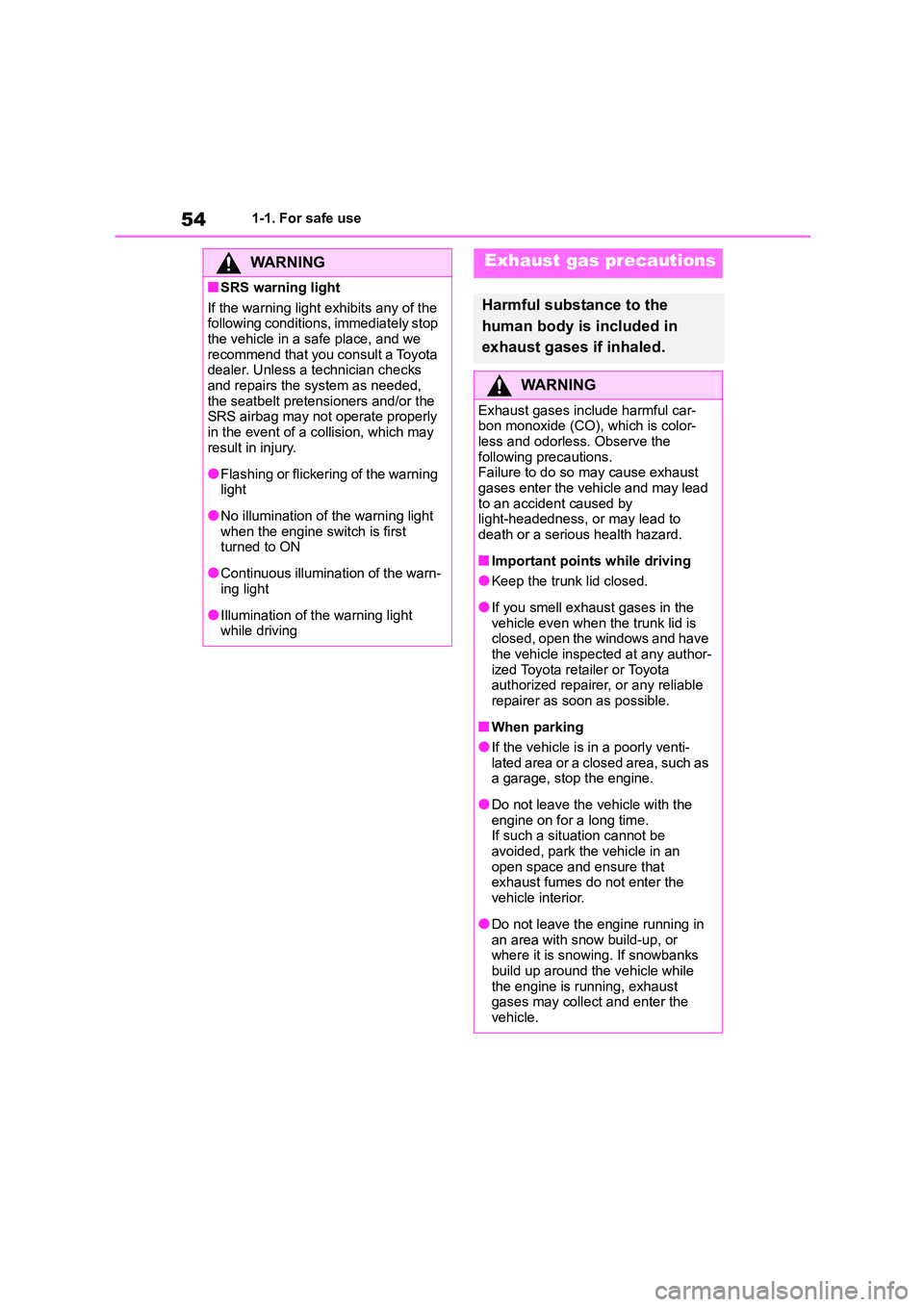
541-1. For safe use
WA R N I N G
■SRS warning light
If the warning light exhibits any of the
following conditions, immediately stop the vehicle in a safe place, and we
recommend that you consult a Toyota
dealer. Unless a technician checks and repairs the system as needed,
the seatbelt pretensioners and/or the
SRS airbag may not operate properly
in the event of a collision, which may result in injury.
●Flashing or flickering of the warning light
●No illumination of the warning light when the engine switch is first
turned to ON
●Continuous illumination of the warn-
ing light
●Illumination of the warning light
while driving
Exhaust gas precautions
Harmful substance to the
human body is included in
exhaust gases if inhaled.
WA R N I N G
Exhaust gases include harmful car-
bon monoxide (CO), which is color-
less and odorless. Observe the following precautions.
Failure to do so may cause exhaust
gases enter the vehicle and may lead to an accident caused by
light-headedness, or may lead to
death or a serious health hazard.
■Important points while driving
●Keep the trunk lid closed.
●If you smell exhaust gases in the
vehicle even when the trunk lid is closed, open the windows and have
the vehicle inspected at any author-
ized Toyota retailer or Toyota authorized repairer, or any reliable
repairer as soon as possible.
■When parking
●If the vehicle is in a poorly venti-
lated area or a closed area, such as a garage, stop the engine.
●Do not leave the vehicle with the engine on for a long time.
If such a situation cannot be
avoided, park the vehicle in an open space and ensure that
exhaust fumes do not enter the
vehicle interior.
●Do not leave the engine running in
an area with snow build-up, or where it is snowing. If snowbanks
build up around the vehicle while
the engine is running, exhaust gases may collect and enter the
vehicle.
Page 121 of 582
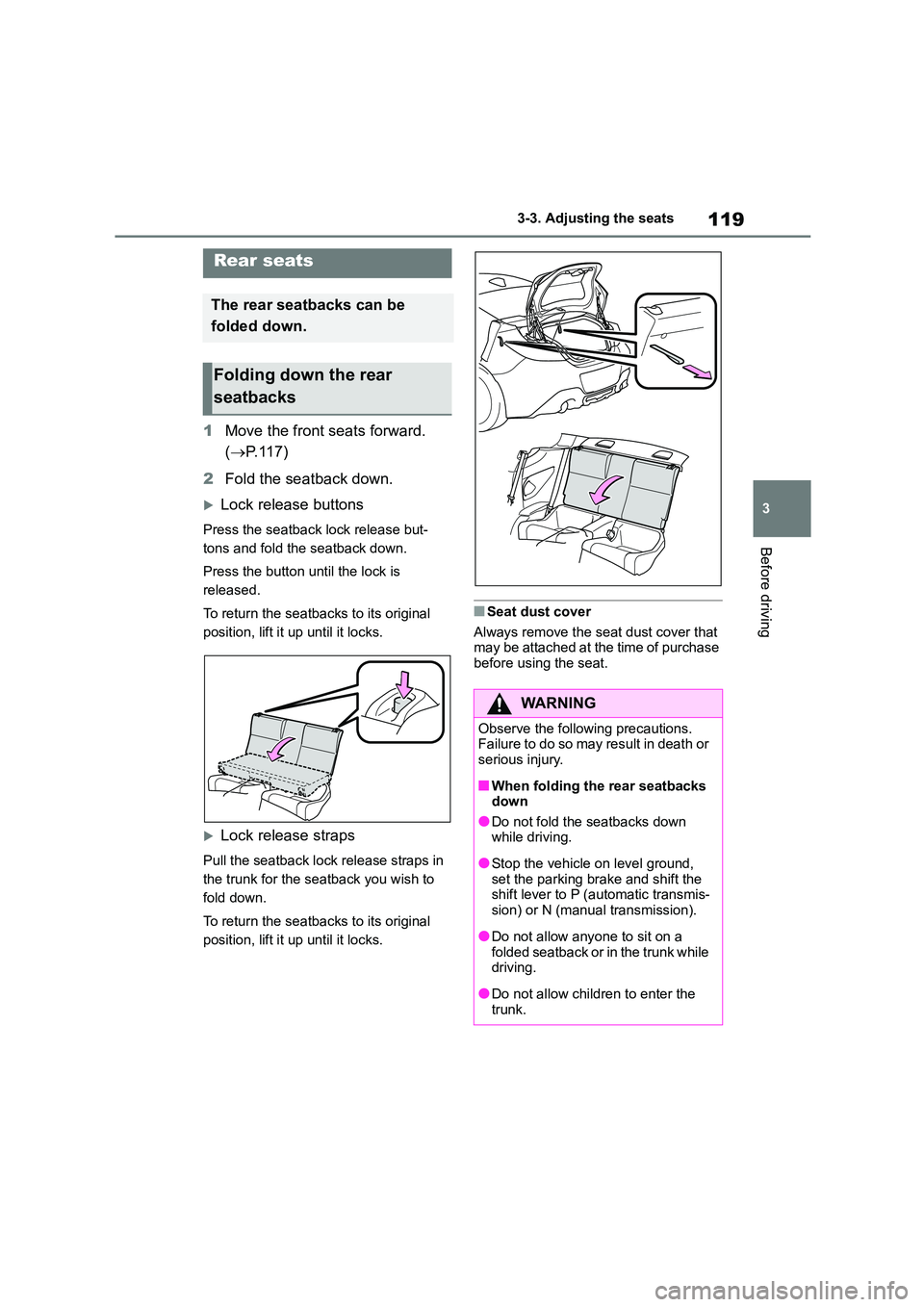
119
3
3-3. Adjusting the seats
Before driving
1 Move the front seats forward.
( P. 1 1 7 )
2 Fold the seatback down.
Lock release buttons
Press the seatback lock release but-
tons and fold the seatback down.
Press the button until the lock is
released.
To return the seatbacks to its original
position, lift it up until it locks.
Lock release straps
Pull the seatback lock release straps in
the trunk for the seatback you wish to
fold down.
To return the seatbacks to its original
position, lift it up until it locks.
■Seat dust cover
Always remove the se at dust cover that may be attached at the time of purchase
before using the seat.
Rear seats
The rear seatbacks can be
folded down.
Folding down the rear
seatbacks
WA R N I N G
Observe the following precautions.
Failure to do so may result in death or serious injury.
■When folding the rear seatbacks down
●Do not fold the seatbacks down
while driving.
●Stop the vehicle on level ground,
set the parking brake and shift the shift lever to P (automatic transmis-
sion) or N (manual transmission).
●Do not allow anyone to sit on a
folded seatback or in the trunk while
driving.
●Do not allow children to enter the
trunk.
Page 131 of 582

4
129
4
Driving
Driving
.4-1. Before driving
Driving the vehicle ............ 130
Cargo and luggage ........... 137
Trailer towing .................... 138
4-2. Driving procedures
Engine (ignition) switch ..... 139
Automatic transmission .... 143
Manual transmission ......... 147
Turn signal lever ............... 150
Parking brake ................... 151
ASC (Active Sound Control)
....................................... 152
4-3. Operating the lights and wip-
ers
Headlight switch ............... 153
High Beam Assist ............. 156
Rear fog lights .................. 159
Windshield wipers and washer
....................................... 160
4-4. Refueling
Opening the fuel tank cap
....................................... 162
4-5. EyeSight
EyeSight ........................... 165
Pre-Collision Braking System
....................................... 175
Adaptive Cruise Control.... 185
Conventional Cruise Control
....................................... 201
Pre-Collision Throttle Manage-
ment ............................... 209
Lane Departure Warning .. 214
Lane Sway Warning.......... 216
Lead Vehicle Start Alert .... 218
List of alert/notification sounds
........................................ 220
EyeSight malfunction and tem-
porary stop...................... 222
4-6. Using other driving systems
BSD/RCTA ........................ 226
Reverse Automatic Braking
(RAB) system ................. 234
Rear view camera ............. 244
Conventional Cruise Control
........................................ 248
Driving mode select switch
........................................ 252
Hill-start assist control....... 253
Exhaust Gas Filter system
........................................ 255
Driving assist systems ...... 256
4-7. Driving tips
Winter driving tips ............. 260
Page 132 of 582

1304-1. Before driving
4-1.Before driving
■Starting the engine
P. 1 3 9
■Driving
Automatic transmission
1 With the brake pedal depressed,
shift the shift lever to D.
( P.143)
2 Release the parking brake.
( P.151)
3 Gradually release the brake
pedal and gently depress the
accelerator pedal to accelerate
the vehicle.
Manual transmission
1 While depressing the clutch
pedal, shift the shift lever to 1.
( P.147)
2 Release the parking brake.
( P.151)
3 Gradually release the clutch
pedal. At the same time, gently
depress the accelerator pedal to
accelerate the vehicle.
■Stopping
Automatic transmission
1 With the shift lever in D, depress
the brake pedal.
2 If necessary, set the parking
brake.
If the vehicle is to be stopped for an
extended period of time, shift the shift lever to P. ( P.143)
Manual transmission
1 While depressing the clutch
pedal, depress the brake pedal.
2 If necessary, set the parking
brake.
If the vehicle is to be stopped for an extended period of time, shift the shift
lever to N. ( P.147)
■Parking the vehicle
Automatic transmission
1 With the shift lever in D, depress
the brake pedal to stop the vehi-
cle completely.
2 Set the parking brake (P.151),
shift the shift lever to P.
( P.143)
Check the parking brake indicator is
illuminated.
3 Press the engine switch to stop
the engine.
4 Slowly release the brake pedal.
5 Lock the door, making sure that
you have the key on your per-
son.
If parking on a hill, block the wheels as
needed.
Manual transmission
1 While depressing the clutch
pedal, depress the brake pedal
to stop the vehicle completely.
2 Set the parking brake. (P.151)
Check that the parking brake indicator
Driving the vehicle
The following procedures
should be observed to ensure
safe driving:
Driving procedure
Page 133 of 582

131
4
4-1. Before driving
Driving
is illuminated.
3 Shift the shift lever to N.
( P.147)
If parking on a hill, shift the shift lever to
1 or R and block the wheels as needed.
4 Press the engine switch to stop
the engine.
5 Slowly release the brake pedal.
6 Lock the door, making sure that
you have the key on your per-
son.
■Starting off on a steep uphill
Automatic transmission
1 Make sure that the parking
brake is set and shift the shift
lever to D.
2 Gently depress the accelerator
pedal.
3 Release the parking brake.
Manual transmission
1 Make sure that the parking
brake is set and shift the shift
lever to 1.
2 Lightly depress the accelerator
pedal at the same time as grad-
ually releasing the clutch pedal.
3 Release the parking brake.
■When starting off on an uphill
The hill-start assist c ontrol will activate.
( P.253)
■Driving in the rain
●Drive carefully when it is raining,
because visibility will be reduced, the windows may become fogged-up, and
the road will be slippery.
●Drive carefully when it starts to rain,
because the road surface will be
especially slippery.
●Refrain from high speeds when driv-
ing on an expressway in the rain, because there may be a layer of water
between the tires and the road sur-
face, preventing the steering and brakes from operating properly.
■Engine speed while driving (vehi-
cles with an automatic transmis-
sion)
In the following conditions, the engine
speed may become high while driving.
This is due to automatic up-shifting con- trol or down-shifting implementation to
meet driving conditions. It does not indi-
cate sudden acceleration.
●The vehicle is judged to be driving
uphill or downhill
●When the accelerator pedal is
released
●When driving on curves
●When the brake pedal is firmly
depressed
■Restraining the engine output
(Brake Override System)
When the accelerator and brake pedals
are depressed at the same time, the
engine output may be restrained.
■New vehicle break-in driving (the first 1600 km [1000 miles])
The performance and long life of your
vehicle are dependent on how you han- dle and care for your vehicle while it is
new. Follow these instructions during
the first 1600 km (1000 miles):
●Do not race the engine. And do not
allow the engine speed to exceed
4000 rpm except in an emergency.
●Do not drive at one constant engine or
vehicle speed for a long time, either fast or slow.
●Avoid starting suddenly and rapid acceleration, except in an emergency.
●Avoid hard braking, except in an emergency.
The same break-in procedures should
Page 134 of 582
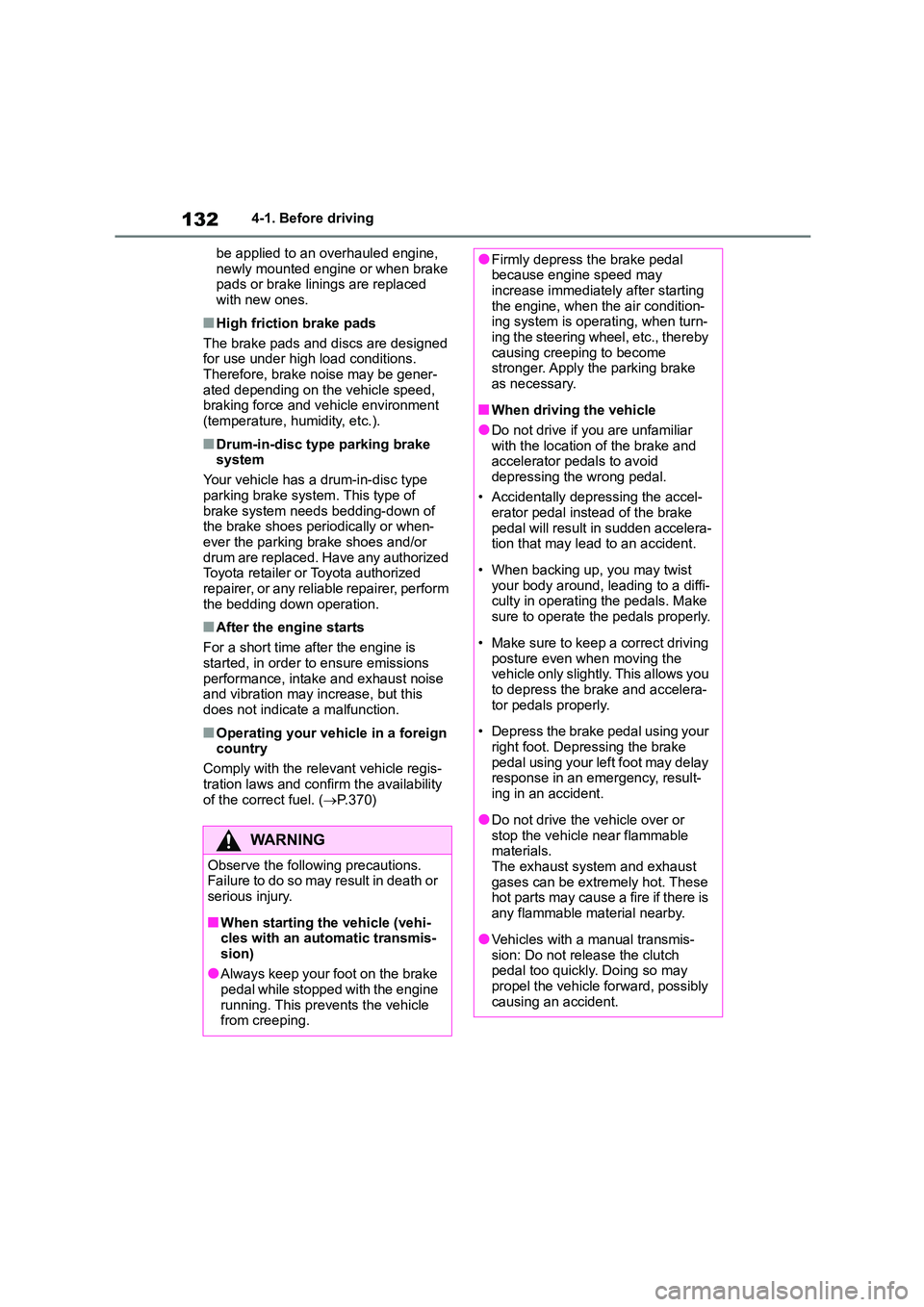
1324-1. Before driving
be applied to an overhauled engine,
newly mounted engine or when brake pads or brake linings are replaced
with new ones.
■High friction brake pads
The brake pads and discs are designed for use under high load conditions.
Therefore, brake noise may be gener-
ated depending on the vehicle speed, braking force and vehicle environment
(temperature, humidity, etc.).
■Drum-in-disc type parking brake
system
Your vehicle has a drum-in-disc type
parking brake system. This type of
brake system needs bedding-down of the brake shoes periodically or when-
ever the parking brake shoes and/or
drum are replaced. Have any authorized Toyota retailer or Toyota authorized
repairer, or any reliable repairer, perform
the bedding down operation.
■After the engine starts
For a short time after the engine is
started, in order to ensure emissions
performance, intake and exhaust noise and vibration may increase, but this
does not indicate a malfunction.
■Operating your vehicle in a foreign
country
Comply with the relevant vehicle regis-
tration laws and confirm the availability
of the correct fuel. ( P.370)
WA R N I N G
Observe the following precautions. Failure to do so may result in death or
serious injury.
■When starting the vehicle (vehi-
cles with an automatic transmis-
sion)
●Always keep your foot on the brake
pedal while stopped with the engine
running. This prevents the vehicle from creeping.
●Firmly depress the brake pedal because engine speed may
increase immediately after starting
the engine, when the air condition- ing system is operating, when turn-
ing the steering wheel, etc., thereby
causing creeping to become stronger. Apply the parking brake
as necessary.
■When driving the vehicle
●Do not drive if you are unfamiliar
with the location of the brake and accelerator pedals to avoid
depressing the wrong pedal.
• Accidentally depressing the accel- erator pedal instead of the brake
pedal will result in sudden accelera-
tion that may lead to an accident.
• When backing up, you may twist
your body around, leading to a diffi- culty in operating the pedals. Make
sure to operate the pedals properly.
• Make sure to keep a correct driving
posture even when moving the
vehicle only slightly. This allows you to depress the brake and accelera-
tor pedals properly.
• Depress the brake pedal using your
right foot. Depressing the brake
pedal using your left foot may delay response in an emergency, result-
ing in an accident.
●Do not drive the vehicle over or
stop the vehicle near flammable
materials. The exhaust system and exhaust
gases can be extremely hot. These
hot parts may cause a fire if there is any flammable material nearby.
●Vehicles with a manual transmis-
sion: Do not release the clutch pedal too quickly. Doing so may
propel the vehicle forward, possibly
causing an accident.
Page 136 of 582

1344-1. Before driving
WA R N I N G
●Vehicles with an automatic trans-
mission: Be careful not to shift the
shift lever with the accelerator pedal depressed. Shifting the shift
lever to a gear other than P or N
may lead to unexpected rapid acceleration of the vehicle that may
cause an accident and result in
death or serious injury.
●Do not place items in the shift
lever's surrounding area. It may
cause incorrect operation.
●If the shift boot is pulled out during
cleaning, return it to its previous position. If the shift boot is left
pulled out, the shift lever may
become difficult to operate.
■If you hear a squealing or scrap-
ing noise (brake pad wear indica- tors)
Have the brake pads checked and
replaced by any authorized Toyota retailer or Toyota authorized repairer,
or any reliable repairer as soon as
possible. Rotor damage may result if the pads are not replaced when
needed.
It is dangerous to drive the vehicle when the wear limits of the brake
pads and/or those of the brake discs
are exceeded.
■When the vehicle is stopped
●Do not race the engine. If the vehicle is in any gear other
than P (automatic transmission) or
N, the vehicle may accelerate sud- denly and unexpectedly, causing an
accident.
●Vehicles with an automatic trans-
mission: In order to prevent acci-
dents due to the vehicle rolling away, always keep depressing the
brake pedal while the engine is run-
ning, and apply the parking brake as necessary.
●If the vehicle is stopped on an incline, in order to prevent acci-
dents caused by the vehicle rolling
forward or backward, always depress the brake pedal and
securely apply the parking brake as
needed.
●Avoid revving or racing the engine.
Running the engine at high speed while the vehicle is stopped may
cause the exhaust system to over-
heat, which could result in a fire if combustible material is nearby.
■When the vehicle is parked
●Do not leave glasses, cigarette
lighters, spray cans, or soft drink
cans in the vehicle when it is in the sun.
Doing so may result in the follow-
ing:
• Gas may leak from a cigarette
lighter or spray can, and may lead
to a fire.
• The temperature inside the vehicle
may cause the plastic lenses and plastic material of glasses to
deform or crack.
• Soft drink cans may fracture, caus-
ing the contents to spray over the
interior of the vehicle, and may also cause a short circuit in the vehicle’s
electrical components.
●Do not leave cigarette lighters in the
vehicle. If a cigarette lighter is in a
place such as the glove box or on the floor, it may be lit accidentally
when luggage is loaded or the seat
is adjusted, causing a fire.
●Do not attach adh esive discs to the
windshield or windows. Do not
place containers such as air fresh- eners on the instrument panel or
dashboard. Adhesive discs or con-
tainers may act as lenses, causing a fire in the vehicle.